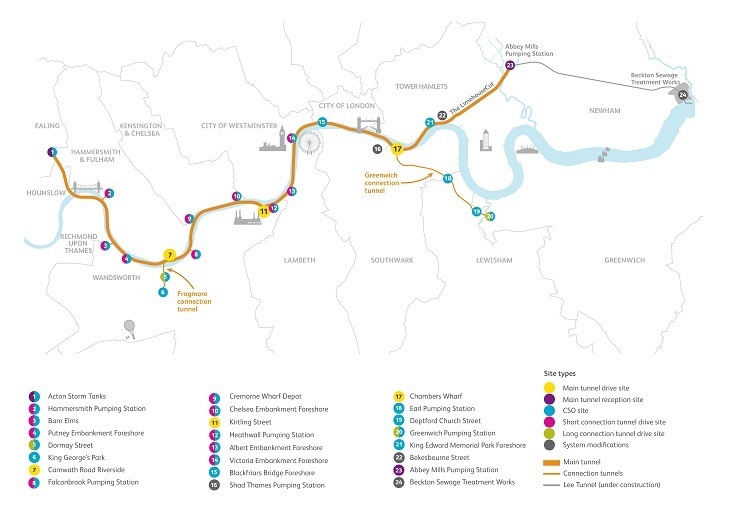In the coming weeks, we will delve into an in-depth analysis of the UK's most notable infrastructure projects to ascertain their current status. Our comprehensive investigation will encompass Crossrail, Tideway, Hinkley Point C, the redevelopment of Battersea Power Station, the Stonehenge Tunnel, HS2, the Leeds Flood Alleviation Scheme, and Birmingham's Big City Plan. For the second project on our list, we will examine the Tideway Scheme—a groundbreaking endeavour that involves the construction of a 25KM super sewer beneath the Thames, aimed at intercepting and managing sewage overflow.
What is the Tideway Scheme?
The Tideway Scheme is a monumental endeavour in the UK, consisting of a 25km long tunnel that reaches depths of up to 70 meters below ground. It holds the distinction of being the largest water infrastructure project ever undertaken in the country. This impressive tunnel, currently under construction, spans from east to west London and serves to modernise and transform the 150-year-old sewer system.
Originally slated for completion in 2024, the Tideway tunnel faced delays due to the Covid-19 pandemic, pushing its expected completion date to 2025. Once operational, the tunnel will intercept storm sewage flows from 34 sewer overflow points along the river Thames. It will then transport the polluted water from Stratford to East Ham Lee Tunnels, ultimately directing it to the Beckton Sewage Treatment Works for thorough treatment. The resulting clean water will be released into the saline Thames Estuary.
A key objective of the Tideway Scheme is to address the overwhelming volume of sewage that exceeds the capacity of London's existing sewerage system. Designed to cater to a population of 4 million people, the system now contends with over 9 million residents in the capital. To alleviate this strain, the Tideway tunnel aims to capture a minimum of 94% of the millions of tonnes of sewage that currently overwhelms the city's sewers.

What Contractors are involved in the project?
· Licensed infrastructure provider Bazalgette Tunnel Ltd, which trades under the name Tideway
· In charge of the Tideway West section are Balfour Beatty Group, Bam Nuttall and Morgan Sindall
· The central section is being undertaken by Ferrovial Agroman UK and Laing O’Rourke Construction.
· Managing the East section of the project are Costain, Vinci Construction Grands Projects and Bachy Soletanche
· Responsible for providing Software systems, communications, process control, reporting and maintenance for the Tideway scheme is Amey.
· Programme manager is Jacobs.
History of the Tideway Scheme
2014 - Planning decisions and approval
2015 - Main works and financing contracts awarded
2016 - Primary work completed, and main works preliminary construction begins
2018 - The start of tunnelling
2019 - Secondary lining begins
2022 - End of the tunnelling
2023 – Testing and commissioning begins
2025 – Project is completed
Where is the Tideway Scheme currently?
Tideway has achieved significant milestones in various locations across its project sites. The eastern section of the Hammersmith pumping station has been fully paved, indicating substantial progress. At the Putney Embankment Foreshore, the teams have successfully removed all sheet piling from the temporary slipway, marking a significant step forward. At the Carnwath Road Riverside site, the cladding has been completely dismantled from the acoustic structure as the dismantling process continues.
In terms of site reinstatement, notable advancements have taken place. At Cremorne Wharf Depot, the reinstatement progress includes the removal of the temporary working platform, which is being replaced with permanent concrete paving slabs, ensuring a long-lasting solution. Similarly, at Chelsea Embankment Foreshore, the reinstatement of the river wall parapet on the eastern side of the site has been completed. The restoration process involved the use of existing granite blocks and coping stones to restore the parapet to its original condition. These efforts aim to maintain the site's integrity and preserve its historical features.
Additionally, ongoing site reinstatement works are underway at Kirtling Street, further contributing to the progress of the Tideway project. These comprehensive reinstatement efforts demonstrate Tideway's commitment to ensuring that the sites are returned to their original state, both functionally and aesthetically.
What's next?
The Tideway Scheme is now entering the next phase, which involves commencing the secondary lining of the Greenwich connection tunnel. With a target completion date set for the first half of 2025, significant progress is being made toward achieving this ambitious goal. For those interested in tracking the developments of this monumental project, a weekly update is provided on the Tideway Tracker. To stay informed and up to date, click here to access the tracker and follow the tunnel's progress.
The Numbers
Here are some improved statements regarding the Tideway tunnel:
The river Thames currently receives a staggering discharge of 39 million tonnes of untreated sewage each year.
Once the Tideway tunnel becomes operational, there will be a remarkable 95% reduction in sewage pollution.
Spanning an impressive length of 25km, the tunnel extends from East to West London, effectively addressing the sewage management needs of the entire city.
The construction of the Tideway tunnel ensures a sewerage system that is not only robust but also capable of meeting the demands of the next 100 years, at the very least.
The estimated cost of the Tideway tunnel project stands at £4.2 billion, reflecting the significant investment required to implement this crucial infrastructure upgrade.
The first infrastructure project we looked at was Crossrail. Click here to read more.
